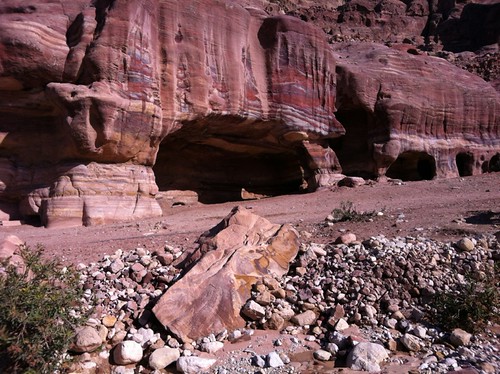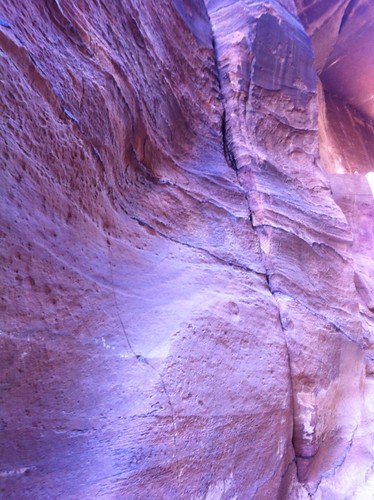As Achebe got from Yeats: things fall apart. One of the ongoing comforts of geology is that everything is always moving, slowly-but-surely. Just as mountains are always rising, other mountains are always being ground down. Actually, all mountains are always being ground down, they only rise if they are eroded at a slower rate than they are pushed up by underlying forces.
But I think erosion is sad. It takes away something that is constructed, often something beautiful, and pulls it to pieces, breaks it down to its component parts, often leaving grey-brown dirt. And no matter how beautiful dirt can be, it’s got nothing on statues and boulders and edifices. I know that without erosion, we wouldn’t have soil in which to grow crops, and hunger is sadder than erosion. So let’s try to understand erosion, or more accurately weathering, better, and hope that understanding it brings some kind of loveliness to the process.
There are 3 kinds of systems that lead to weathering (according, as always, to my Physical Geology by Charles Plummer, Diane Carlson and Lisa Hammersley): the atmosphere, hydrosphere, and biosphere. Or, as I like to say, this (without the Fire):
(And geology totally has Heart, so there’s nothing more to say on that).
We can see examples of all 3 kinds of weathering systems in Petra, Jordan.
Wind: The airborne sand rips of layer-after-layer of skin from the facades every year:

The same forces act on uncarved sandstone above the Nabataean tombs, though ,that result it much more beautiful, exposing the stone’s most vibrant colors: 
Water: Petra’s greatest asset as a commercial hub, beside its protective walls, was its access to and sophisticated distribution of water. But that water is also eating negative-columns into the walls of the Siq:

Water weathers in two ways: chemical weathering, wher the oxygen in water oxidizes water in rocks and CO2 makes a weak acid that eats nearly any mineral eventually and mechanical, where water physically picks up and drags away little (or sometimes large) pieces of a rock.
Biosphere: Some of that carried-away dirt goes to feed plants, one of the residents in the biosphere most responsible for weathering: Plants

Plants and frost and responsible for a lot of big-break-ups of rocks. Their roots find a tiny cracks and dig a little deeper each time. Malvina Reynolds explains it most clearly (though I don’t agree that the grass is living and the stone is dead. The stone’s just a bit slower):
Animals
As Ms Reynolds explains, plants aren’t the only living things which break up stones and contribute to the slow movement of all minerals to the bottom of the oceans. Petra is a monument to the impact humans can have on stone:

From the perspective of rocks, we’re all probably a bit like a fast-moving, particularly destructive breed of grass. We carve stone to build tombs and temples and blow it up to make highways and drill into it to anchor homes. Sometimes, when we stop paying attention, other weathering elements take over our weathering-work:

Other forms of weathering
Another important kind of mechanical weathering that Jordan, because of its perfect climate, doesn’t see much of is frost-action. Anyone who’s ever exploded a bottle of soda left in the freezer knows the power of expanding frozen water. It is responsible for a lot of the tiny cracks which plants and other members of the biosphere dig into. There is both frost-wedging (where frost rips rocks apart, slowly) and frost-heaving (where frost expands under a rock and exposes it to the elements).
There is also pressure release, where rock that has been compacted under the great weight of other rock pops up like a balloon and splits itself to pieces once enough of the oppressive covering has weathered away. Think of it as a wicked case of the bends for igneous rocks, with negative effects for the sedimentary rock above it.
A brief note on the role of oxygen:
All around Jordan and throughout Petra, I kept seeing these black rocks:

And I couldn’t quite figure out why they were black. A lot of Jordan is beige (spectacular reds and maroons of Petra notwithstanding):

I asked our guide during the 2013 TechWomen trip to Jordan what caused those black rocks and he said it was the same thing which made gave Petra its colors: manganese oxide. When manganese oxide interacts with oxygen, it moves from its usual deep red to black. See how the same rock face changes colors as it gets higher (and closer to the weathering winds):

There were also much darker veins in some places in the Siq in Petra, see below with a quarter for a size reference (shout-out to my Geology teacher at Carnegie Mellon for letting me know the importance of size references and the cheat of using pocket-change):

I’m not entirely sold that manganese oxide is the entire story, since its didn’t seem to weather equally in veins where I would expect it to be distributed evenly, but it is a theory to go on.
Conclusion
The ways in which the rocks of Petra are ground down–air, water, living things–are also generally the ways in which any rock weathers, along with extreme cases of chemical weathering like acid rain or mechanical weathering like pressure release. From the perspective of archeologists, the weathering of the monuments at Petra is a bad thing, because it reduces the amount of time they have to discover the 95% of Petra that has not been studied. But from the perspective of the rocks? It’s just going to happen.
Inspirational Quote:
“Rocks are records of events that took place at the time they formed. They are books. They have a different vocabulary, a different alphabet, but you learn how to read them.”- -John McPhee
Jessica,
Fantastic photos. You can come to the geology class any time and give a guest lecture on weathering. Terrific examples of differential weathering!
Oh, and there are other great John McPhee books to read, if you have not already done so.
Jim